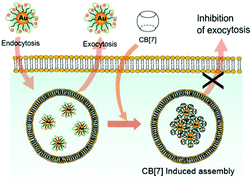Prolonged retention of internalized nanoparticulate systems inside cells improves their efficacy in imaging, drug delivery, and theranostic applications. Especially, regulating exocytosis of the nanoparticles is a key factor in the fabrication of effective nanocarriers for chemotherapeutic treatments but orthogonal control of exocytosis in the cellular environment is a major challenge. Herein, we present the first example of regulating exocytosis of gold nanoparticles (AuNPs), a model drug carrier, by using a simple host–guest supramolecular system. AuNPs featuring quaternary amine head groups were internalized into the cells through endocytosis. Subsequent in situ treatment of a complementary cucurbit[7]uril (CB[7]) to the amine head groups resulted in the AuNP-CB[7] complexation inside cells, rendering particle assembly. This complexation induced larger particle assemblies that remained sequestered in the endosomes, inhibiting exocytosis of the particles without any observed cytotoxicity.
